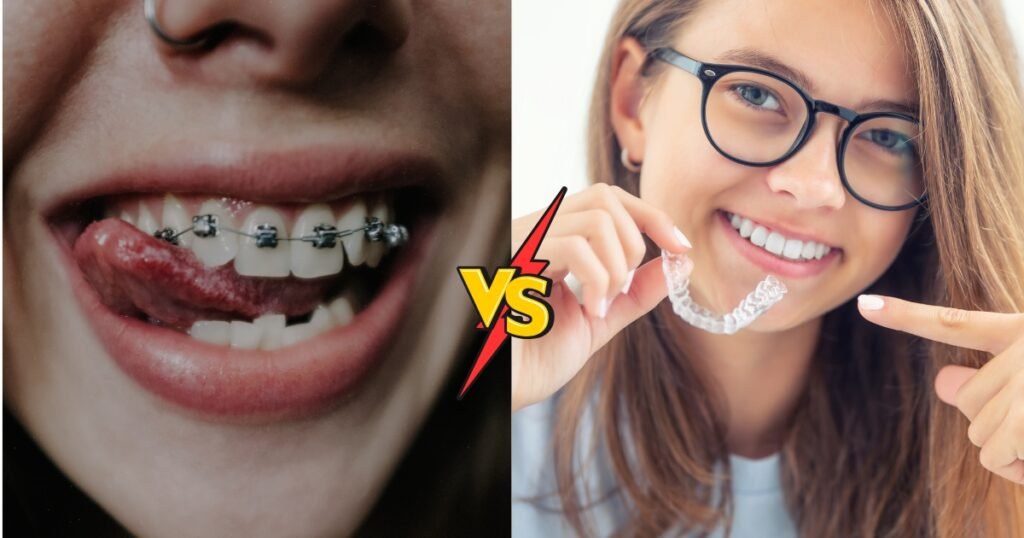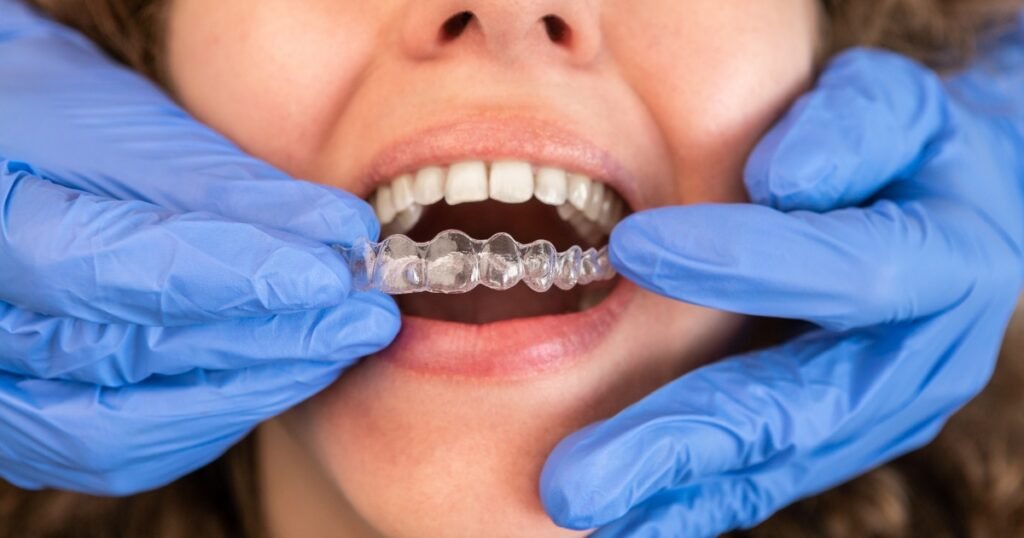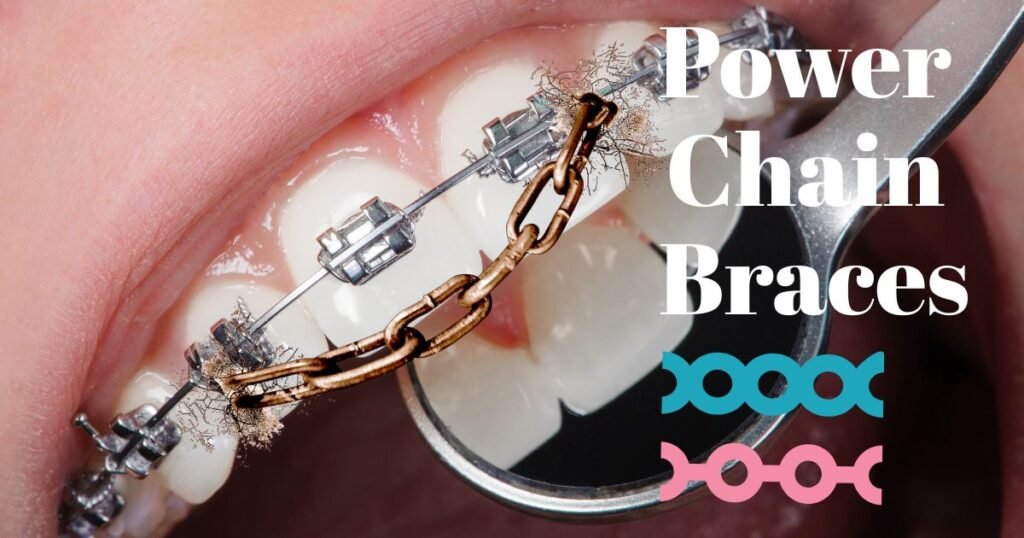A Personal Story: From Wires to Clear Aligners
Months ago, Sara stood in front of a mirror, her tongue probing the metal brackets on her teeth. Three months into her orthodontic treatment. The discomfort, the food restrictions, and the self-consciousness were beginning to outweigh the excitement. One evening, over dinner, a friend smiled, showing me her nearly invisible clear aligners. That’s how the question hit: Can you switch from braces to Invisalign after starting with metal brackets?
Sara isn’t alone. Many people who begin with braces end up wanting to know if Invisalign is a better choice. If you’re thinking the same, here’s a guide to help you.
Can You Switch from Braces to Invisalign?
Yes, you can move from braces to Invisalign. But it is not an option for everyone. Your eligibility is based on your stage of treatment, how much alignment correction is ongoing, and your orthodontist’s recommendation.
A 2022 study from the American Journal of Orthodontics and Dentofacial Orthopedics found that nearly 17.2 percent of patients switched treatment types during their orthodontic experience, with many of them wondering: Can you switch from braces to Invisalign mid-treatment? The answer, in most cases, is yes, with the proper planning.
Why Would Anyone Want to Switch?
You’re no stranger to the downsides of braces: sores in your mouth, food trapped in your wires, not to mention cleaning. Invisalign seems much more like a clean, effortless solution. Naturally, the first question you start to wonder is, can you switch from braces to Invisalign and still get great results?
Here, some of the most common reasons patients want to switch:
- Aesthetic Appeal – Invisalign is clear and almost transparent.
- Comfortable: No metal brackets or wire are poking in your cheeks.
- Comfort – Clear aligners are removable, so you can eat or drink whatever you want.
- Social Confidence – At public events or in the office, people change social dynamics.
Braces vs. Invisalign: What’s the Difference?

When you know how each treatment functions, you can determine if you can transfer from braces to Invisalign without sacrificing the results.
| Feature | Braces | Invisalign |
|---|---|---|
| Visibility | Noticeable metal or ceramic | Clear and nearly invisible |
| Comfort | Can irritate gums/cheeks | Smooth and less irritating |
| Removability | Fixed in place | Removable by patient |
| Oral Hygiene | Harder to clean | Easy cleaning with removal |
| Food Restrictions | Many foods are off-limits | No restrictions with aligners |
| Checkups | Monthly wire adjustments | New aligners every 1-2 weeks |
| Treatment Duration | 18–36 months | 6–18 months (case dependent) |
| Cost | Slightly lower | Slightly higher |
This table is useful if you’re trying to decide if you can switch from braces to Invisalign without giving up treatment progress or convenience.
How Does the Switch Work?
Maybe you’re even curious to know how, precisely, you can make the switch from braces to Invisalign? So here are a few steps that we might follow:
- Orthodontist Examination – Your orthodontist finds out if switching is feasible.
- Take braces off – If agreed, your braces are gently taken off.
- Digital Scans/Impressions – These are needed for your custom aligners.
- Begin Invisalign – Aligners are provided in a series, which are changed every 1-2 weeks.
Now the issue is not whether can you switch from braces to Invisalign, but the question becomes when you can switch and how good it will work.
Factors to Consider Before Changing

But before you take the plunge, some things to consider.
1. Treatment Stage
If you’ve already had significant movement of your teeth from braces, the remainder may be more modest work. In those cases, yes, you can make the transition from braces to Invisalign with relative ease.
2. Complexity of Your Case
Invisalign does a great job with mild to moderate cases. But if your care includes multiple rotations, deep overcrowding, or bite issues, your orthodontist might recommend sticking with braces. That doesn’t mean you can’t change — it means your doctor or provider must tailor the plan for you.
3. Discipline & Compliance
A big difference is responsibility. Braces work passively — you don’t have to think about them. Invisalign, though, requires discipline. If you are not wearing them 20–22 hours a day, they will not work as well. Examine what you want to do: Can you alone go from having braces to having Invisalign and be set on that amount of use every single day?
4. Financial Considerations
Sometimes, a switch can involve added expenses. Contact your orthodontist to see if there are fees involved. In that case, insurance companies would not cover Invisalign if braces were initially covered. The financial question: Can You Switch from Braces to Invisalign? — merits a frank discussion with your provider.
What Do the Studies Say?

A 2021 review of studies published in Frontiers in Dentistry concluded that for many alignment problems, Invisalign is similar to braces in terms of effectiveness. But patient compliance is a major contributor to Invisalign’s efficacy. So, yes, you can transition from braces to Invisalign — but your commitment is a factor.
A study in 2023 found that patients who had used Invisalign had statistically significantly higher reported satisfaction in several aspects, including maintenance of tooth appearance and comfort, although patients who used braces had a statistically significant) Greater final tooth alignment.
What Patients Say After Switching

Let’s revisit Sara. After half a year in braces, she transitioned to Invisalign. The biggest change? Her confidence. Dining in restaurants, smiling for pictures, or talking at work became easier. She still had to be diligent about wearing her aligners, but she often answered, “Yes, you can change from braces to Invisalign, and it can change your life every day.”
Stories like Sara’s are a real-world reminder that your choice doesn’t just have consequences for your teeth — it also shapes, in no small way, how you’ll live for years with braces on your teeth.
Pros and Cons of Making the Switch

Pros
- Better appearance
- More comfort
- Easier brushing and flossing
- Fewer office visits
Cons
- For complex problems may not be adequate
- Requires self-discipline
- Potential added cost
- If you cannot tolerate it, it may prolong the duration of total treatment.
Despite the downsides, many patients find the benefits to be worth the concerns, especially when they ask themselves, “Can you switch from braces to Invisalign and feel better about the process?”
Final Thoughts
It’s not just a dental decision when you switch from braces to Invisalign, it’s a lifestyle decision. It provides the flexibility, confidence, and comfort that metal brackets frequently do not. But as with any big health decision, it comes with duties.
So talk to your orthodontist, get the whole story, and know how committed you are. Many patients have successfully switched, and you can, too — if it fits you and you have the determination.
Now that you know the answer to the question, can you switch from braces to Invisalign? Do you think it’s the right move for you?
Assess Your Cavity Risk in 30 Seconds – Complimentary & Simple!
This is a fast and simple way to see how likely you are to get cavities based on your day-to-day activities, such as brushing your teeth, flossing, sugar consumption, and visits to the dentist. Simply respond to a few easy questions and immediately receive your own personal cavity risk score, as well as practical tips for saving your smile. It’s free, it’s fast, and it’s less than a minute!
🦷 Cavity Risk Checker
FAQs on Can You Switch from Braces to Invisalign
Can you switch from braces to Invisalign mid-treatment?
Yes, a lot of patients are able to transfer from braces to Invisalign while going through orthodontic treatment, depending on the severity of their case and how much has been done so far.
Your orthodontist will evaluate if your teeth are at a point where Invisalign can wrap up the alignment.
There are still some extreme cases where traditional braces need to be used to finish the job.
Custom aligners are created based on a digital scan or impression of your new treatment plan.Is it more expensive to switch from braces to Invisalign?
Changing from braces to Invisalign may cost you an additional sum of your treatment because of new diagnostics, aligner making, and additional appointments.
How Much Does Invisalign Cost? Invisalign costs between $3,000–$9,000.
If you have already begun orthodontic treatment with braces, additional costs may apply.
Both treatments may not be covered completely by some insurance plans, so verify with your provider.How long does Invisalign take after switching from braces?
The length of treatment with Invisalign still has everything to do with how much correction is left to make after having your braces removed.
For mild to moderate cases, Invisalign usually requires 6–18 months.
A new estimate will be given by your orthodontist based on your progress.
Wearing 20-22 hours per day is necessary to prevent delays.Will I need to restart treatment if I switch from braces to Invisalign?
No, you don’t start over from the beginning, but a new treatment plan will be created based on your new alignment.
The progress you have made with braces is considered.
Aligners are personalized to progress from where braces ended.
You might have to add to or tweak this pattern to get good movement.Are the results the same when switching from braces to Invisalign?
Yes, Invisalign outcomes are similar to those of braces, if your case is a good, clear aligner candidate.
For mild to moderate crowding or spacing, Invisalign works well.
Complicated cases may require a hybrid approach or perhaps minor in-brace corrections initially.
The result is highly dependent on patient cooperation and good user behavior.

Dr. Niraj Ghanghoriya is a passionate dental surgeon with over 12 years of experience in clinical dentistry. He completed his BDS from the prestigious Sri Aurobindo Institute of Dentistry in 2012 and specializes in painless root canals, smile makeovers, and preventive oral care. Known for his patient-first approach and clear communication, Dr. Ghanghoriya aims to make dental knowledge accessible to everyone. When he’s not in the clinic, he enjoys writing informative dental blogs to help people take better care of their oral health.





